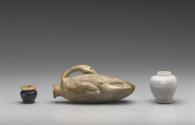Advanced Search
Ointment jar in the form of a trussed duck
Egyptian
Middle Kingdom–2nd Intermediate Period, Dynasty 13-17
1991–1550 B.C.
Place of Origin: Egypt
Medium/Technique
Anhydrite
Dimensions
Width x height x depth: 6.2 x 15 x 7.4 cm (2 7/16 x 5 7/8 x 2 15/16 in.)
Credit Line
Gift of Horace L. Mayer
Accession Number65.1749
CollectionsAncient Egypt, Nubia and the Near East
ClassificationsVessels
DescriptionCosmetics and other toiletries were highly valued by the ancient Egyptians. Both men and women wore eye makeup, which served to protect the eyes from the bright sun and from blowing sand and dust. Pigment was made either from green malachite (a type of copper ore) or from grayish black galena (lead ore) and was kept in a powdered form generically known as kohl. Perfumed unguents, made from oils or fats scented with flowers, herbs, spices, and resins, were prized for their rare ingredients and were used both in the daily cosmetic regimen of wealthy Egyptians and as funerary offerings to anoint the bodies of the dead.
This vessels is carved from pale blue anhydrite, a stone favored by the makers of cosmetic vessels in the Middle Kingdom and Second Intermediate Period, although rarely found in contexts dating to other eras. The source of this beautiful stone remains unidentified.
This larger jar, an ointment vessel, is carved in the form of a trussed goose, and is one of about a dozen such objects known. Ducks and geese were popular motifs for cosmetic vessels, spoons, and other toiletry items throughout the history of Egyptian art. The technical skill of the artist is superb. The details of the bird's head, folded wings and webbed feet are carefully rendered, and the eyes are inlaid. The yellowish tone of the head and neck are the result of natural veining in the stone.
This vessels is carved from pale blue anhydrite, a stone favored by the makers of cosmetic vessels in the Middle Kingdom and Second Intermediate Period, although rarely found in contexts dating to other eras. The source of this beautiful stone remains unidentified.
This larger jar, an ointment vessel, is carved in the form of a trussed goose, and is one of about a dozen such objects known. Ducks and geese were popular motifs for cosmetic vessels, spoons, and other toiletry items throughout the history of Egyptian art. The technical skill of the artist is superb. The details of the bird's head, folded wings and webbed feet are carefully rendered, and the eyes are inlaid. The yellowish tone of the head and neck are the result of natural veining in the stone.
ProvenanceBy 1961: Horace L. Mayer (d. 1968) collection; lent by Horace L. Mayer to the MFA in 1961; given by Horace L. Mayer to the MFA.
(Accession Date: December 29, 1965)
(Accession Date: December 29, 1965)




